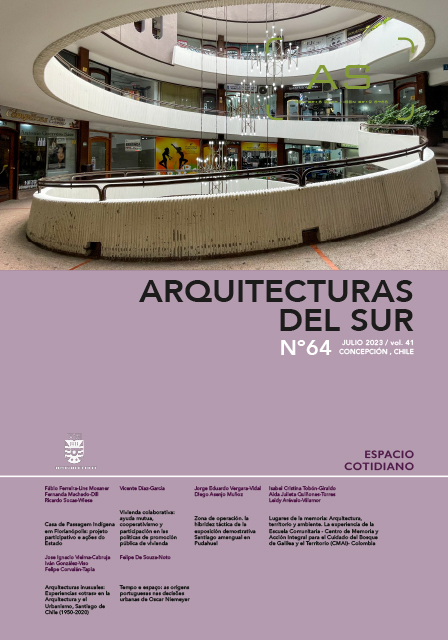Tempo e espaço: As origens portuguesas nas decisões urbanas de Oscar Niemeyer
DOI:
https://doi.org/10.22320/07196466.2023.41.064.06Palavras-chave:
arquitetura moderna brasileira, Oscar Niemeyer, espaços livre e edificado, projeto urbano, estratégias projetuaisResumo
O urbanismo no Brasil se apropriou da tradição urbanística na mesma medida em que a arquitetura moderna pioneira? Este artigo constrói uma resposta a este questionamento, que passa pelo desdobramento teórico da definição do termo espaço a partir do reconhecimento de duas concepções historicamente aceitas. Parte da apresentação breve das genealogias e principais aspectos destas concepções, como suporte metodológico para a leitura de seu rebatimento na obra de Oscar Niemeyer; cerca as estratégias projetuais em duas obras do arquiteto, o projeto para a Praça XV no Rio de Janeiro (1991) e para o conjunto urbano de Pena Furada, em Portugal (1965). Com noções emprestadas de outros campos disciplinares, propõe uma interpretação da incorporação do tempo como elemento mediador da experiência espacial: como marco literal – impresso nas referências concretas à tradição ‒ e como elemento gerador das decisões espaciais ‒ ao ser incorporado na experiência do deslocamento.
Downloads
Referências
ABBAGNANO, N. (2007). Dicionário de Filosofia. São Paulo, Martins Fontes.
ALLEN, S. T. (2008). From object to field. Practice: Arquitecture. Technique and Presentation. Londres / Nova York: Routeledge.
CABRAL, C. (2018) Niemeyer e o Atlântico: duas narrativas costeiras. Revista Interfaces, (28), 87-101. Recuperado em: http://hdl.handle.net/10183/189269
EINSTEIN, A. (2010). Introdução. In: Jammer, Max. Conceitos de espaço: a história das teorias do espaço na física. (23-29). Rio de Janeiro, Contraponto PUC-Rio.
MAHFUZ, E. (2002). O Clássico, o Poético e o Erótico. Porto Alegre, Editora das Faculdades Integradas do Instituto Ritter dos Reis.
NIEMEYER, O. (1966). Conjunto Urbanístico de Pena Furada. Memorial Descritivo. Fundação Oscar Niemeyer. Descrição. Coleção Oscar Niemeyer, 1966. Recuperado em: www.niemeyer.org.br
NIEMEYER, O. (1991). Urbanização da Praça XV. Fundação Oscar Niemeyer. Descrição. Coleção Oscar Niemeyer. Recuperado em: www.niemeyer.org.br
PETIT, J. (1988). Niemeyer: Poeta da Arquitetura. Milão: Fidia Edizioni D’Arte.
ROWE, C. & KOETER, F. (1983). Collage City. Cambridge, The MIT Press.
SENNET, R. (2008). Carne e pedra. O corpo e a cidade na civilização ocidental. Rio de Janeiro, BestBolso.
TÁVORA, F. (2004). Da organização do espaço. Porto, FAUP Publicações.
TEIXEIRA, M. (2012). A forma da cidade de origem portuguesa. São Paulo: Unesp.
TELLES, S. S. (1988). Arquitetura Moderna no Brasil: o desenho da superfície. Dissertação de Mestrado, São Paulo: FFLCH USP.
WISNIK, G. (2004) Modernidade Congênita. In: Forty, Adrian & Andreoli, Elisabetta. Arquitetura Moderna Brasileira. (22-55). Londres: Phaidon.
WISNIK, GU. (2022). Tentando não afundar na lama: impasses da modernidade brasileira. ARS (São Paulo), 20(46), 24-74. DOI: https://doi.org/10.11606/issn.2178-0447.ars.2022.205227
Downloads
Publicado
Como Citar
Edição
Secção
Licença
Direitos de Autor (c) 2023 Felipe De Souza-Noto

Este trabalho encontra-se publicado com a Licença Internacional Creative Commons Atribuição-CompartilhaIgual 4.0.

O conteúdo dos artigos publicados em cada número da Arquitectura del Sur, é de responsabilidade exclusiva dos autores e não representam necessariamente o pensamento, ou compartem a opinião da Universidade de Bío-Bío. Os autores têm seus direitos autorais conservados, e garantiram à revista o direito de primeira publicação e difusão de sua obra. A publicação do artigo na Arquitectura del Sur estará sujeita à Licencia de Reconocimiento de Creative Commons CC BY-SA isso permite que outros se Adaptem: remixam, transformam e constroem o material para qualquer finalidade, inclusive comercialmente, Compartilhe: copie e redistribua o material em qualquer meio ou formato, desde que a autoria e a primeira publicação desta revista sejam reconhecidas, citando-a corretamente , bem como suas novas criações estão sob uma licença com os mesmos termos.













 Programa de Información Científica/Concurso Fondos de Publicación de Revistas Científicas 2018/ Proyecto Mejoramiento de Visibilidad de Revistas UBB (Código:FP180007)
Programa de Información Científica/Concurso Fondos de Publicación de Revistas Científicas 2018/ Proyecto Mejoramiento de Visibilidad de Revistas UBB (Código:FP180007) 
